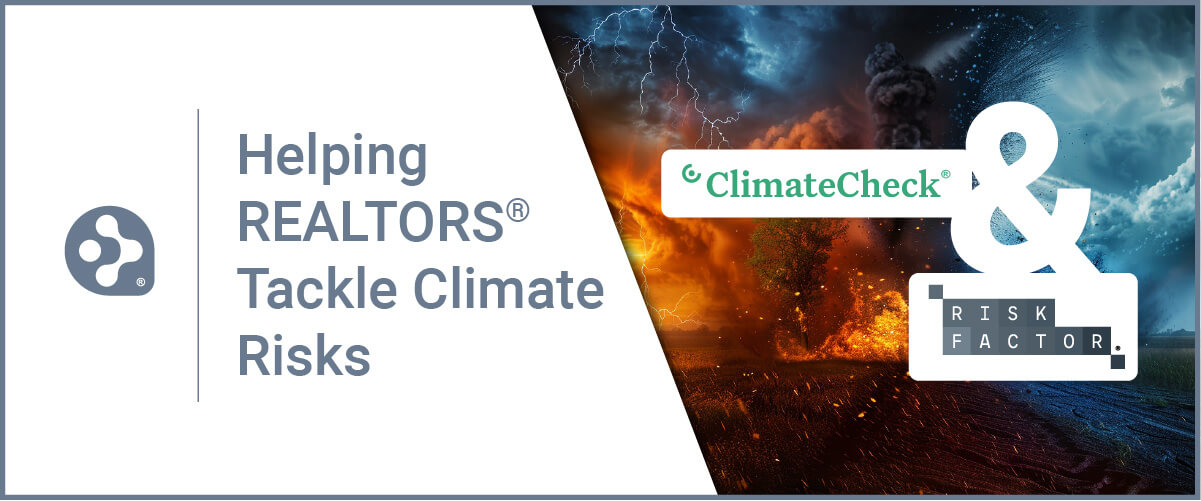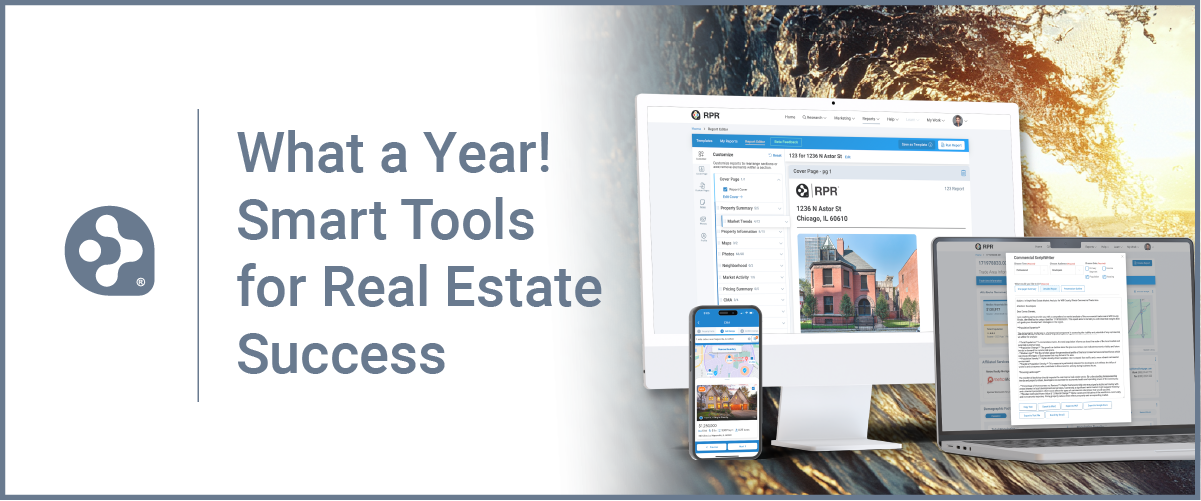Climate Change and Real Estate: How RPR Partner Integrations Can Help Navigate the Risks

Climate change is no longer a distant threat. The impacts of rising temps and rising sea levels to the increased frequency and intensity of wildfires, floods and other natural disasters is being felt across the U.S. and the globe.
And while climate change poses significant challenges to the planet and the population, it’s also starting to have negative consequences on various financial and business sectors, including real estate.
Home values and associated costs such as homeowners insurance are increasingly affected by these environmental shifts, making it crucial for homeowners, buyers and REALTORS® to understand and mitigate those risks.
Tools like RPR’s (Realtors Property Resource) ClimateCheck® and Risk Factor™ integrations are becoming essential in navigating this new and ever-evolving landscape. REALTORS® who use RPR can easily tap into these tools to gauge risks and threats, and guide their clients accordingly.
The impact of climate change on home values
Before we dive into how ClimateCheck and Risk Factor can help agents, let’s look at some of the stats and facts about climate change and its impact on real estate and home values. The following is an excerpt from a study conducted by First Street, the brains behind Risk Factor and an industry-leading physical climate risk data provider:
Nearly half of all U.S. homes are threatened by extreme weather conditions, according to a new analysis that examines the potential impact of climate change on the country’s housing market.
Across the nation, roughly $22 trillion in residential properties are at risk of “severe or extreme damage” from flooding, high winds, wildfires, heat or poor air quality… and such dangers can impact home prices, drive up insurance costs and even destabilize the broader housing market.
Other key findings:
As you can see from the above stats, climate change is having and will have a significant impact on the housing and real estate industries, and homeownership as a whole. Here are some ways that it could affect home values:
- 1
Increased frequency of natural disasters: Properties in areas prone to hurricanes, floods, wildfires and other natural disasters are at higher risk. This increased risk can lead to higher insurance premiums and lower property values. For instance, coastal properties vulnerable to rising sea levels and storm surges may see a decline in desirability and market value.
- 2
Shifting climate zones: As temperatures rise, regions previously considered temperate may become less habitable, affecting their attractiveness and, consequently, their real estate values. Conversely, areas that were once too cold may become more desirable, potentially driving up their property values.
- 3
Regulatory changes: Governments are increasingly implementing regulations aimed at mitigating climate change impacts. These regulations can affect property values positively or negatively. For example, properties that are not compliant with new energy efficiency standards may require costly upgrades, which can affect their market value.
- 4
Infrastructure and community resilience: Communities that invest in resilient infrastructure and disaster preparedness tend to maintain higher property values. Conversely, areas lacking such investments may see a decline in property desirability and value.
RPR’s ClimateCheck and Risk Factor Integrations
RPR has integrated two powerful tools, ClimateCheck and Risk Factor, to help real estate professionals and their clients navigate the complexities of climate change-related risks.
ClimateCheck and Risk Factor are accessible through RPR when REALTORS® conduct a search and get results for a specific property.
On the Property Details page, just scroll down a bit and look to the right for the “Additional Resources” section. There users can click through to each site to gather hazard risk scores and ratings, relative to that property.

ClimateCheck
ClimateCheck® ratings reflect hazard risk at a property relative to the rest of the contiguous United States. Ratings are based on projected 2050 risk, to reflect a typical 30-year mortgage commitment, and the change from historical risk.
ClimateCheck provides detailed insights into climate risk at the property level. It evaluates various factors, including heat, drought, fire, flood and storm risks, offering a comprehensive climate risk score. This information is crucial for several reasons:
- 1
Informed Decision-Making: Buyers can make more informed decisions by understanding the long-term climate risks associated with a property. This helps in assessing whether the property is a sound investment.
- 2
Future-Proofing Investments: For investors, ClimateCheck can identify properties that are more likely to maintain or increase in value despite climate change, enabling more strategic investment decisions.
- 3
Mitigation Strategies: Homeowners can use ClimateCheck data to implement mitigation strategies, such as improving property resilience through upgrades, which can help maintain or enhance property values.
Risk Factor
Risk Factor assesses a property’s risk from floods, wildfires, hurricane wind and extreme heat, and presents the results in a property-specific score. Risk Factor provides interactive maps to compare risk of nearby homes, and specific solutions to minimize risk.
Risk Factor focuses on assessing the risk of flooding, a significant concern as climate change leads to more extreme weather events. Key features include:
- 1
Detailed flood risk information: Risk Factor provides property-specific flood risk data, helping buyers understand the likelihood of flooding over the lifetime of a property. This information is crucial for properties in flood-prone areas where traditional flood maps may not provide sufficient detail.
- 2
Impact on insurance and value: By understanding flood risks, homeowners can better anticipate changes in insurance premiums and property values. This transparency can lead to more accurate pricing and market positioning.
- 3
Community and infrastructure insights: Risk Factor also offers insights into community-level flood risks and resilience measures. This helps buyers and investors assess the broader context of a property’s flood risk, including local infrastructure and community preparedness.
RPR climate-focused partners = more informed decisions
As climate change continues to impact real estate, tools such as RPR’s partnership with ClimateCheck and Risk Factor are invaluable for navigating this evolving landscape.
By providing detailed, property-specific climate and flood risk information, these tools empower real estate professionals, buyers and investors to make more informed decisions.
Embracing these tools is not just a smart move—it’s essential for anyone involved in the real estate market today and in the future.
* CBS News, March 13th, 2024, Nearly half of U.S. homes face severe threat from climate change, study finds
Share This Story, Choose Your Platform!
TOPICS
AUDIENCE
CATEGORIES
TUTORIALS & GUIDES
SUCCESS STORIES
PROSPECTING
THE PODCAST


















